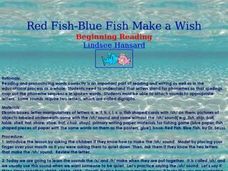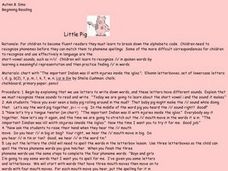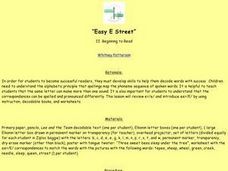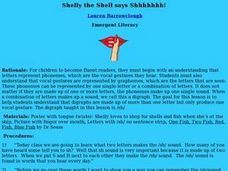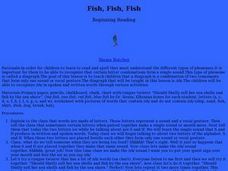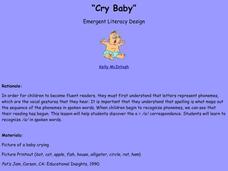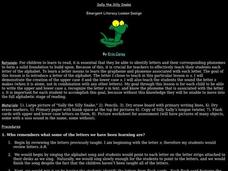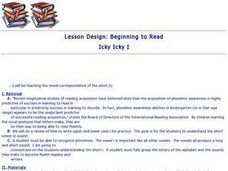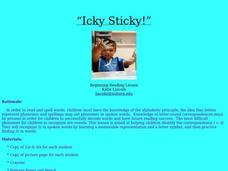Curated OER
I Think I Can
Students identify the digraph /ch/ in written and spoken language. Students practice the production of the /ch/ sound through tongue twister. They identify the initial and final placement of the digraph /ch/ by reading a story to a partner.
Curated OER
Red Fish-Blue Fish Make a Wish
Young scholars to read and pronounce words correctly. They investigate the letters that stand for phonemes so that spellings map out the phoneme sequence in spoken words. Students attach sounds to appropriate letters. They have some...
Curated OER
Ugly Umbrellas
First graders make the /u/ sound together and repeat a sentence that contains several /u/ words until they become familiar with it. They raise their hand to tell which word contains the /u/ sound and then use letterboxes to spell words...
Curated OER
Little Pig
First graders discover that letters are used to write words and that they have different sounds. They pronounce the word, "pig" emphasizing the /i/ sound. They say a tongue twisters that features the /i/ sound in each word. They then...
Curated OER
"Easy E Street"
Students investigate how the same letter can make more than one sound. It is also important for students to understand that the correspondences can be spelled and pronounced differently. This lesson will review e=/e/ and introduce ee=/E/...
Curated OER
Here Comes the Choo Chooooooo!!
Students practice exercising the phoneme/digraph that makes the /ch/ sound. They drill on the tongue twister, "Charles chatted while he waited on his chance to win a check," and encounter Elkonin boxes along with the book, "Chad Checks,"...
Curated OER
Icky Sticky Tin Man
Students recognize the short vowel i in written and spoken language. Through listening and matching activities, they discriminate the vowel sound /i/ from other phonemes. Students associate the phoneme with its letter representation and...
Curated OER
Shelly the Shell
First graders identify the digraph /sh/ in written and spoken language. Students practice the production of the /sh/ sound through word practice and stories. They identify the initial and final placement of the new digraph /sh/ using a...
Curated OER
Shelly Shark Goes Shopping
Students identify the digraph /sh/ in written and spoken language. Students practice the production of the /sh/ sound through words and tongue twisters. They identify the initial and final placement of the new digraph /sh/ through...
Curated OER
Fish, Fish, Fish
Students identify the digraph /sh/ in written and spoken language. After a brief discussion the independent and combined sounds of the phonemes /s/ and /h/ students practice identifying initial and final placement of the new digraph /sh/...
Curated OER
What's Behind the Creaky Door?
First graders are introduced to the concept that letters stand for the mouth moves that we make when sounds are made. They practice making the /e/ sound and compare it to the sound a creaky door makes and then try saying the tongue...
Curated OER
Cry Baby
Students recognize the short vowel a in written and spoken language. Through matching and listening activities, they discriminate the vowel sound /a/ from other phonemes. Students associate the phoneme with its letter representation...
Curated OER
Sally the Silly Snake
Students practice identifying letters and their corresponding phonemes to become solid fluent readers. They focus on the grapheme and phoneme associated with the upper and lowercase letter of S. Each student makes the sound that the...
Curated OER
Silly Snake
Students practice recognizing and sounding out the letter S. They listen to the alphabet song, "Sea Shell," by Amy Lowell, and view a large picture of a snake in the shape of the letter S. Each student points out other objects found in...
Curated OER
What's Up Doc?
Students demonstrate the /o/ sound by opening up their mouth and saying, "Ahhhhh". They try saying a tongue twister that contains the /o/ phoneme; repeating it two times together. They then practice writing the letter /o/ so that it can...
Curated OER
Icky Icky I
First graders review the letter "i" and use popsicle sticks and cotton balls to make upper and lower case "i's". Volunteers make the capital and lower case "i" on the board and then the class discovers the short sound that letter "i"...
Curated OER
Open Up and Say /o/
First graders listen to a variety of words to see if they can recognize the /o/ sound. They use letterboxes and letters discovering that each mouth moves gets its own box practicing forming words with the /o/ vowel sound. They then read...
Curated OER
Elephants Enjoy Eating Eggs
Pupils recognize the short vowel e in written and spoken language. Through listening and matching activities, they discriminate the vowel sound /e/ from other phonemes. Students practice using the phoneme and letter in words by writing...
Curated OER
Say Aaaaa for Apple
Learners say words by blending sounds and phonemes. They decode words in order to read and identify and understand the letter a. This phoneme /a/ is one of the short vowels that are needed to read and write. They will show example of...
Curated OER
Icky Sticky
Students recognize the short vowel i in written and spoken language. Through matching and listening activities, they discriminate the vowel sound /i/ from other phonemes. Students identify the phoneme and letter in words and pictures.
Curated OER
Language Arts: Understanding Phonemes
Students discover the relationship between letters and phonemes. The teacher leads an oral demonstration of pronunciation and focus on the /a/ sound. Next, students examine a series of pictures, circling the ones where they hear the...
Curated OER
Giddyup Gilbert
First graders think about telling a horse to go faster by saying "giddyup" every time they hear the /g/ sound. They say the /g/ sound together and try to hear the sound in the word frog and then practice saying a tongue twister making...
Curated OER
Mmmmmm Mmmmmm Yum!
Young scholars engage in an emergent literacy instructional activity that focuses on phonemic awareness. The importance of the letter to sound relationship is stressed in the instructional activity. The letter "m" is the target phoneme...
Curated OER
Shiny Shells on the Shore
Young scholars investigate how: A single phoneme, which is a vocal gesture in spoken words, can be represented by more than one grapheme. Also how a digraph is the combination of two letters that make one sound (there are both vowel and...

